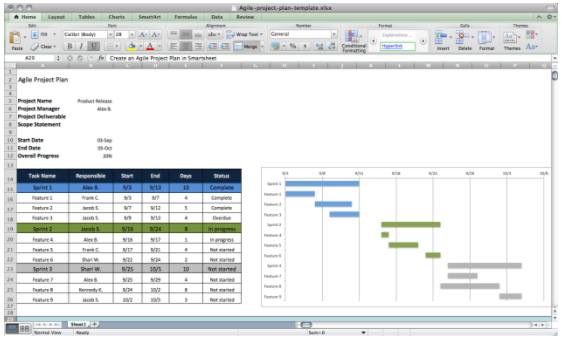How adopting an Agile Roadmap will help your project
In recent years, a new project planning method has become important. Many organizations have recognized the potential of the Agile method. Also realizing traditional approach to planning and management may not be effective always. This realization is true in the fields of IT and new product development. As a result, many organizations value flexibility in their project development practices. That is the ability to react to opportunities, or the need for changes mid-stream.
The old approach does not take into account the reality of many modern projects. Agile roadmap Project Management (Agile PM) reflects a new era in project planning. It lays emphasis on flexibility and takes into account evolving customer requirements. Agile approach to project management recognizes the importance of evolving customer needs. It allows for an incremental and iterative planning process. Thus, today, the adaptive approach to Agile wins over predictive Waterfall approach.
What is an agile roadmap?
Let’s discuss - what is a roadmap.

Image Source:https: //slidehunter.com/powerpoint-templates/agile-roadmap-powerpoint-template/
Figure 1: Agile Roadmap Template
Roadmap definition
The roadmap is a plan or strategy that helps in reaching milestones. During new product development, we observe various changes in requirements throughout project phases. To respond back to these frequent changes, an Agile approach needs to be in place. An agile project roadmap prepares you to manage all changes. In fact, an Agile roadmap is a living document, which explains how the product is likely to be.
An agile development roadmap is successful only when planned well. The traditional Waterfall approach has planned at its core. A traditional roadmap demands a long-term engagement to creating specific features. An agile roadmap deals with inescapable changes while still pursuing the product vision. It conveys a short-term agile project plan for attaining product goals. It also takes into account the customer's value and needs.
Scope
In a traditional waterfall model, we should complete each phase before moving on to the next. A formal review should take place to find out if the project is on track at the end of each phase. During a review, we can determine whether to continue or discard the project. The main characteristic of the traditional model is that the phases don’t overlap. The predictive waterfall project development process works if:
- Requirements are known and frozen at the outset of the project.
- Product definition is stable and not subject to changes.
- Understanding of Technology.
- Ample resources with required expertise are available.
- The project duration is short.
But what happens, If requirements change in the middle of the project’s development?
Or
If the customer delivers a new set of “critical” features that have to be part of the final product?
Or
When a new technological innovation allows the team to better streamline the product.
Or
If the initial assumptions or project scope were not communicated properly?
Or
A competitor beats us to the market with an identical product?
With projects that need flexibility, the traditional model could prove to be a rigid process. A process that will fail to deliver value to the customer. This is because of changing needs or the inability to explain the requirements. It is to address these critical issues that Agile Project management has emerged.
How to create a roadmap?
Steps to build/develop a roadmap

Image Source: https://www.slideshare.net
Figure 2: Agile project management process flow
- Develop strategy
To begin with, an agile roadmap, develop a sound strategy that includes product’s vision and goals. A product vision expresses the product value you are adding to customers. The goals articulate what you expect in the product, with defined metrics. In the absence of well-defined product vision and goals, there is a risk of scrum teams going off-track.
- Explore strategic themes
There is a need to Explore strategic themes through Initiatives or Epics. The initiatives are further broken down into features and user stories. The strategic initiatives help you with top-level work necessary to achieve goals. These initiatives also help to convey the Agile roadmap strategy to stakeholders.
- Cross-functional collaboration
An agile roadmap needs frequent communication between product owner and development team. Collaboration between organization and customers is desirable in building the roadmap. An agile roadmap asks for harnessing and leveraging the efforts of all cross-functions. Each of them contributes to delivering a complete user based product experience.
- Connect user stories to strategic themes
A product manager can break down strategic themes into features in an Agile roadmap. The development teams decompose these features into design requirements. Following this, the scope is estimated and organized into sprints. It results in a backlog of user stories and features with an obvious connection to strategy. During roadmap, if there is any change in goals, the prioritized work should also change.
- Release evolving new user experiences
An agile release delivers a product value considering the consumers' changing experiences. Unlike a sprint or iteration, agile release delivers a new user experience. It is the product manager’s responsibility to optimize the new customer experience. The releases convey to customers about what features they should expect and by when.
- Gather Customer ideas
Customers are pivotal in an agile roadmap approach for collecting opinions, ideas, feedback. Once you collect these ideas for enhancing the product value, they should be a priority for future release backlog. Thus, customer ideas are also important to product’s vision and goals.
- Review the results
On agile roadmap, you can measure the progress towards strategic vision and goals. You can review the defined metrics for predictability and agility. You can also assess the business impact of newly generated ideas on features. You can adapt to short-term inevitable changes by reviewing the roadmap. Also accommodating the adjustments with user experience and feedback.
Purpose and Effectiveness of agile project management
Agile Project Management is also known as Scrum. It understands that the project cannot be in line with original specifications throughout. Thus, ensuring the completed project will be a “success.” For example, software projects are prone to constant change. Creating a plan and then disengaging from the customer may be the traditional approach to Project Management. But, it is dangerous with complex or uncertain projects.
Agile Project Management applies to projects that are prone to constant change. So the planning function changes from traditional up-front to throughout development cycle.
In effect, Agile Project Management makes development a “rolling wave” process of a continuous plan.
In Scrum, the aim of each wave is to increase value by developing sub-features or elements in the project. The length of these development iterations is short. Long enough to create some valuable addition to the project that customers can check. But, short enough to remain in constant communication.
Following each development cycle, a review meeting takes place. During this review, the features are evaluated, changes agreed to, specifications modified. Also, the next deliverable is identified.
Agile Project Management reduces the uncertainty in traditional approach by avoiding common mistakes.
Ask yourself, is traditional approach effective in a software project?
The traditional approach involves a process of building requirements for the project, finishing the product, and then testing it. In turn, finding hundreds of bugs and unneeded or nonworking features.
Instead, what is desirable is smaller but still usable sub-features. They will be completed one at a time, tested and verified. In this case, any changes to the software are not expensive - either time or money.
How to design a roadmap for your team?
One of the differences between Agile and traditional is the nature of roles taken up.
In traditional project planning, the project developer’s viewpoint is the most important. Developers look at the project from an inside perspective. That is, how long will development take? How many work packages and tasks are necessary to complete the project? Project developers perform the tasks because they allow them to plan the work with accuracy and build the cost estimates. The more detailed and specific the project is, the easier it is to create these plans and estimates.
While, in an Agile roadmap, Scrum Master is the person who takes the project forward. He/she removes impediments or resolves differences of opinion between major stakeholders. The Scrum Master is not the project manager but has a formal role in enforcing the rules.
Scrum Masters focus on the Agile project development and do not play a role in people management. The product owner is the person representing the stakeholders. The product owner may be a member of the project organization, but he/she must take the “outside” user’s viewpoint.
The product owner creates user stories that identify their specific needs for the product. Development team handles delivering the product at the end of each iteration (Sprint). The development team is cross-functional and self-organizing.
The Scrum Master, Product Owner, and Development team form a Scrum team in an Agile roadmap. In an Agile roadmap, the scrum team can share their inputs and the deliverable on a real-time basis.
A Project Development roadmap should consider the product strategy with clear vision and goals.
- Define strategic themes or initiatives to help you work towards your goals.
- Organize cross-functional teams to deliver value to customers.
- Development teams to define clear user stories linked to product strategy and vision.
- Release incremental values to customers within schedule.
- Manage the complete customer experience.
- Collect customer feedback on the releases.
- Measure progress towards your strategic goals on a regular basis.

Image Source: https://www.smartsheet.com/agile-project-management-excel-templates
Figure 3: Agile project plan example
Benefits of using a roadmap in the project team
Following are the significant benefits of using roadmap in project team:
- Responds to any mid-course changes in requirements.
- Synchronize product vision, goals and initiatives to come up with products as expected.
- Customers’ requirements are a priority. Accommodate any user experience during the roadmap.
- Helps to capture user inputs through feedback and make changes then and there itself. Don't have to wait for getting user response after completion of product development.
- Brings team collaboration to share real-time inputs. And strengthens communications.
Conclusion
In today’s dynamic market, frequent changes in requirements are common. To confront these inevitable changes, a traditional roadmap is not enough. An agile roadmap is capable of responding to these changes as and when they appear. Agile implementation is gaining popularity among project management professionals. If you are not agile today, you may end up in a big crisis soon. So, follow the steps above to build an agile product roadmap for your team. And prepare yourself to safeguard your challenging projects and delight your customers.
Get an in-depth understanding of Project Management here!
